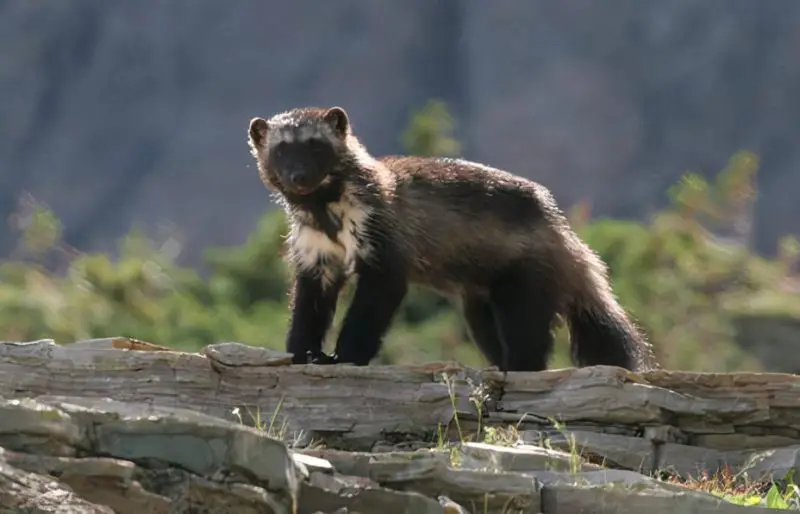Wolverines move through Montana’s rugged wilderness with a level of mystery and scientific fascination that few other mammals evoke. Rarely seen but powerfully present within alpine basins, remote conifer forests, and high-elevation snowfields, these muscular carnivores carry a reputation that far exceeds their size. With broad heads, thick fur, and bearlike strength packed into a compact frame, wolverines survive in one of the harshest climates in the continental United States.
Montana hosts some of the largest remaining wolverine populations in the Lower 48, particularly in areas like Glacier National Park, the Bob Marshall Wilderness, the Bitterroot Range, and parts of the Greater Yellowstone Ecosystem. These landscapes—defined by deep snow, jagged peaks, and isolated valleys—provide the cold, remote habitats wolverines require. Their behavior, metabolism, travel distances, and ecological interactions reveal a species shaped by extremity.
Here are 11 astonishing facts about wolverines in Montana that highlight their strength, intelligence, resilience, and importance in the state’s mountain ecosystems.
1. Wolverines in Montana Can Travel 20 to 30 Miles in a Single Night

They Cross Mountain Ranges Effortlessly
Wolverines have incredibly large home ranges, with males covering territories up to 500 square miles. Montana’s steep peaks and snowy valleys do not slow them down. Their enormous paws act like snowshoes, allowing them to move swiftly across deep snow where many predators struggle.
This adaptation allows them to patrol territories far larger than those of most carnivores.
Their mobility helps them locate scarce food resources in winter.
Their Daily Energy Expenditure Is Enormous
Their metabolism is extremely high. To maintain energy, wolverines travel constantly, seeking carrion, small mammals, berries, or winter-killed ungulates. Their ability to burn calories rapidly allows them to explore vast distances without fatigue.
This physical endurance is unmatched among similarly sized mammals.
Their roaming lifestyle helps maintain genetic diversity across Montana.
Their Movement Patterns Adapt to Snow Conditions
Wolverines prefer landscapes with consistent spring snowpack. Snow helps them travel efficiently and store food. When snow levels change, they adjust routes, altering elevation and direction accordingly.
This sensitivity to snowpack shapes their distribution across Montana’s mountain ranges.
Montana’s cold climate supports one of the most stable wolverine populations in the country.
2. Wolverines Possess Jaw Strength Comparable to Animals Much Larger
Their Bite Can Crack Frozen Bones
Wolverines are famous for cracking large ungulate bones—moose, elk, bighorn sheep—even during subzero temperatures. Their jaw pressure allows them to access marrow that other predators can’t reach.
This winter advantage supports survival during food scarcity.
Their bone-crushing ability is one of their most defining traits.
Their Skull Design Prevents Damage
The shape of a wolverine’s skull distributes force evenly, allowing them to crush dense material without injuring themselves. This specialized design supports a diet heavy in carrion and frozen meat.
This structural strength evolved in response to harsh northern ecosystems.
Montana’s long winters have shaped their feeding adaptations.
Their Teeth Are Built for Shredding Tough Tissue
Sharp molars and thick incisors help wolverines tear hide, tendons, and muscle. No part of a carcass goes to waste. They consume fur, bone fragments, and sinew with ease.
This ability allows them to scavenge year-round.
Wolverines are nature’s ultimate recyclers.
3. Montana Wolverines Use Snow Dens to Raise Kits
Deep Snow Provides Insulation
Female wolverines dig dens beneath snow drifts, downed logs, and talus slopes. These snow structures protect newborn kits from predators and weather.
Montana’s consistent snowpack is essential for successful reproduction.
Snow dens maintain stable temperatures despite Montana’s severe winters.
Dens Are Multi-Chambered and Hidden
A maternal den may include several chambers: sleeping areas, kit nurseries, and escape tunnels. Females defend these dens fiercely, relocating kits only when absolutely necessary.
These complex structures increase kit survival rates.
Their engineering skill reflects deep evolutionary intelligence.
Snowpack Decline Threatens Denning
As spring snowpack becomes less predictable, wolverines face challenges in finding suitable denning locations. Montana’s northern ranges remain some of the last reliable strongholds.
Snowpack stability is directly tied to long-term population survival.
This dependence on snow is why scientists monitor their habitat closely.
4. Wolverines Can Smell Food Beneath Several Feet of Snow
Their Olfactory System Is Exceptionally Advanced
Wolverines detect carcasses buried under snow or hidden in thick forests. Their sense of smell rivals that of canids but is fine-tuned for locating frozen meat.
This ability allows them to capitalize on winter-killed prey.
Their winter foraging success depends heavily on scent.
They Locate Caches Left by Other Animals
Wolverines frequently steal food from bears, mountain lions, and foxes. They detect hidden caches through layers of ice and soil, allowing them to exploit the leftovers of larger predators.
This scavenging flexibility increases their chances of survival.
They are true opportunists of the northern mountains.
Their Scent Detection Aids Navigation
Wolverines recognize territory boundaries and travel routes using scent markers left by other individuals. This scent-based communication prevents unnecessary conflict.
Olfactory mapping plays a role in maintaining stable territories across Montana’s wilderness.
Their communication system is subtle but highly effective.
5. Wolverines Are Surprisingly Intelligent and Solve Complex Problems
They Display Problem-Solving Skills Similar to Some Primates
Studies show wolverines can open latches, navigate obstacles, and remember food locations months later. Their intelligence supports survival in dynamic environments.
This cognitive ability is essential for scavenging and caching food.
Their memory allows them to return to old caches even after storms.
They Learn From Experience
Wolverines adapt quickly to new challenges—avoiding traps, altering travel routes, and recognizing human presence. Individuals remember areas of disturbance and shift behavior accordingly.
This learning capacity helps them thrive in remote and changing landscapes.
Montana’s diverse terrain reinforces these adaptive behaviors.
They Communicate Through Body Language and Scents
Wolverines use scent glands to mark territory and display subtle behaviors during mating season. Their communication relies on chemical and behavioral signals.
This system supports population spacing and reduces aggression.
Their intelligence extends into social interactions.
6. Wolverines Are Stronger Than They Look
Their Muscular Build Allows Extraordinary Movement
Despite weighing only 20–40 pounds, wolverines can drag animals many times their size. They yank frozen carcasses up slopes or over obstacles with brute strength.
This strength is essential for feeding in winter.
Their body is built for endurance, not speed.
They Climb Trees, Boulders, and Cliff Faces
Their claws and agility allow them to climb vertical surfaces, escape predators, or reach cached food. Wolverines also scale steep cliffs in pursuit of prey.
This climbing ability expands their habitat range across Montana’s mountains.
Their agility is surprising for their stocky build.
Their Digging Strength Is Remarkable
Wolverines dig dens, cache sites, and escape tunnels through snow, soil, and even compacted ice. Their powerful limbs support these digging activities.
This combination of strength and versatility is unmatched among mid-sized carnivores.
Their morphology is perfectly suited to northern wilderness.
7. Wolverines Are Solitary Yet Maintain Huge Territories
They Rarely Interact Outside Breeding Season
Wolverines avoid direct contact with others to reduce competition. Each individual occupies vast terrain marked with scent glands.
This solitary lifestyle maximizes food availability.
Territories vary depending on prey abundance.
Males Overlap Territories With Multiple Females
This reproductive strategy ensures genetic exchange across large regions. Males patrol boundaries frequently, leaving scent markers.
This spacing supports a healthy, well-connected population.
Territory overlap helps maintain genetic flow across mountain ranges.
Juveniles Disperse Great Distances
Young wolverines leave their birth territory and may travel over 100 miles to establish new ranges. This dispersal helps maintain genetic diversity throughout Montana.
Their dispersal paths often cross mountain passes and remote valleys.
These long journeys reflect incredible physical endurance.
8. Wolverines Steal Food From Larger Predators With Stunning Boldness
They Confront Bears and Mountain Lions
Wolverines are known to challenge black bears, grizzlies, and mountain lions over carcasses. Their ferocity and persistence often intimidate these predators.
This boldness stems from their survival-driven metabolism.
Even large carnivores hesitate to fight them directly.
They Enter Kill Sites Without Fear
Wolverines assess risk quickly and dart into kill sites to steal meat. Their agility allows them to escape before predators retaliate.
This scavenging strategy gives them access to calorie-rich food.
Montana’s predator-rich ecosystems support this competitive behavior.
They Cache Stolen Food Throughout Their Territory
Wolverines drag meat far from kill sites and store it under snow or logs. Cold temperatures keep caches fresh for weeks.
This caching technique provides emergency food reserves.
Caching is essential in severe winter months.
9. Wolverines Thrive in Harsh Environments That Many Species Avoid
They Prefer Cold, High-Elevation Landscapes
Montana’s alpine basins and snowy ridges provide ideal conditions. Wolverines rely on cold climates to reduce competition and stay efficient.
They seldom remain in warm, low-elevation habitats.
Their distribution follows snow, not food alone.
Harsh Weather Gives Them a Competitive Edge
Blizzards and deep snow reduce predator activity, but wolverines remain active. Their thick fur and metabolism allow them to hunt or scavenge in conditions others avoid.
Weather extremity shapes their ecological niche.
Montana provides some of the last strongholds for cold-adapted carnivores.
They Thrive on Solitude
Wolverines succeed in areas with minimal human disturbance. Montana’s wilderness areas—like the Bob Marshall and Glacier—offer the isolation they require.
These refuges preserve stable wolverine populations.
Their survival depends on remote habitats.
10. Wolverines Influence Montana’s Ecosystem More Than People Think
They Regulate Carrion Distribution
By caching and transporting remains, wolverines redistribute nutrients across landscapes. Their movements help cycle organic material.
This nutrient spread benefits scavengers, plants, and microbes.
They serve as ecological engineers.
They Control Small Mammal Populations
Wolverines hunt rodents, marmots, hares, and other small mammals. This predation influences population dynamics throughout mountain ecosystems.
Their hunting stabilizes prey communities.
They contribute to ecological balance.
They Support Predator–Scavenger Networks
Wolverines interact with eagles, coyotes, bears, and wolves through scavenging webs. Their presence strengthens biodiversity and trophic complexity.
This interconnectedness makes them essential to Montana’s mountain ecology.
Their niche role extends far beyond direct predation.
11. Wolverines Are Rarer Than Most People Realize
They Are Naturally Low-Density Animals
Even in optimal habitat, wolverine densities remain extremely low. Individuals cover huge areas, limiting total population size.
Montana supports only a few hundred individuals.
Their rarity contributes to their mysterious reputation.
Climate Change Threatens Their Snow-Dependent Lifestyle
Decreased snowpack affects denning success and population stability. Montana’s northern mountains remain critical refuges as other regions warm.
Their vulnerability makes conservation efforts urgent.
Snowpack monitoring supports long-term survival.
Human Disturbance Can Fragment Their Range
Roads, recreation, and development impact travel corridors. Wolverines prefer remote, undisturbed landscapes and may abandon areas with excessive human traffic.
Connectivity is essential for population health.
Conservation management focuses on preserving large habitat corridors.
FAQs About Wolverines in Montana
Are wolverines dangerous to humans?
They avoid humans and rarely pose threats unless cornered.
How many wolverines live in Montana?
Estimates vary, but Montana has one of the largest populations in the Lower 48.
Do wolverines hibernate?
No, they remain active year-round.
Where can I see wolverines in Montana?
Remote areas of Glacier National Park, the Bob Marshall Wilderness, and high alpine terrain.
What do wolverines eat most?
Carrion, small mammals, birds, berries, and winter-killed ungulates.
How big do wolverines get?
Typically 20–40 pounds, but extremely strong for their size.
Do wolverines climb trees?
Yes, they climb trees, cliffs, and boulders with ease.
Why are wolverines so rare?
Large territories, low reproductive rates, and habitat sensitivity limit population size.
Conclusion
Wolverines in Montana are among the most astonishing mammals in North America. Their physical power, intelligence, snow-dependent lifestyle, immense travel distances, and fierce independence make them perfectly suited to Montana’s rugged wilderness. Yet their rarity and sensitivity to climate and habitat change highlight the importance of conserving large, intact mountain landscapes.
Understanding these 11 mind-blowing facts reveals a species shaped by extremity—one that symbolizes the resilience, wildness, and ecological richness of Montana’s high country. Protecting wolverines means preserving the untouched wilderness they depend on, ensuring that these remarkable animals continue to roam the state’s snow-covered peaks for generations to come.






